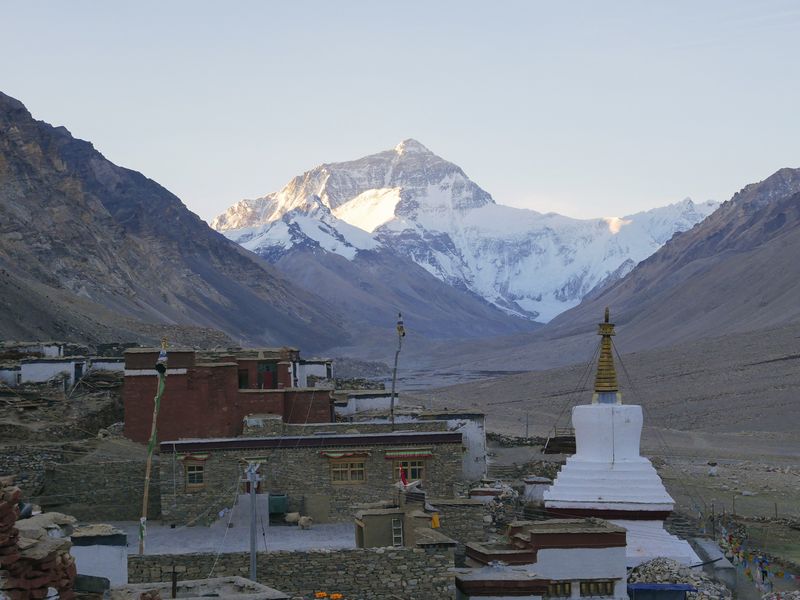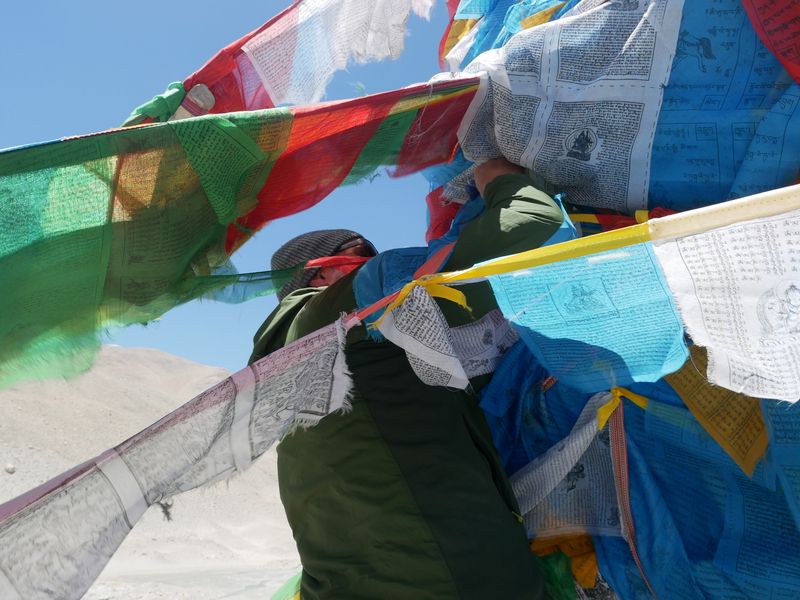Aim for the Summit
As unique travel experiences go, trekking across the ‘roof of the world’ in Tibet, at an average elevation of 4,500m, is hard to beat. It’s not the easiest destination to get to, but the unparalleled rush of standing in one of Earth’s rawest landscapes is like nothing else. As with all our destinations, you have to experience Tibet for yourself to begin to properly understand its subtleties. It makes for uncomfortable learning at times, including the impact that modern development has had on the landscape, but its history is fascinating, nuanced and complex.
Whether you arrive in Lhasa by flight from Kathmandu, or take the overnight train from central or eastern China, it’s a revelatory journey into a singular city. Leave Lhasa’s urban hub after a few days’ exploration and stop for a night each in Gyantse, Shegar, Rongbuk and Shigatse to experience more of the region’s culture. There’ll be plenty of time to take in some breathtaking views along the way, including one of the most remarkable on the planet - gazing up the valley towards Mount Everest itself.
Ideally, visit Tibet in the relatively short early-summer window when the skies are clearest, which becomes crucial as you leave the city and move towards the mountains. Don’t be fooled by the constant backdrop of snow-capped peaks: the temperature varies enormously, getting extremely hot during the day (despite the altitude) and extremely cold at night. We’ll take care of all the complexities and keep you on the right track; all you have to do is put in the trekking miles and make sure you pause often to memorise every detail of the extraordinary landscape.
The first day in Lhasa can be overwhelming, as you navigate this contrasting city’s wildly different quarters whilst acclimatising to being 3,656m above sea level. It can take a couple of days to even out! Although many of the places of interest are on the outskirts, we relish the bits in between: the back streets behind the monasteries and the early morning markets.
A city in the clouds
Lhasa is a city of two halves: the modern quarter feels unremarkable, but suddenly you turn a corner and find the bustling markets and fabled cobble streets of Old Lhasa, with pilgrims circumnavigating the central Jokhang Temple. For more than a thousand years, pilgrims have trodden these sacred paths with devotion in their hearts, charging the Jokhang with a powerful ambiance of sanctity.
Early morning in Lhasa is like no other. Food carts gather in the predawn darkness; guards exit their slumber at their posts by the Potala Palace as the sun rises; and the sound of prayer wheels spinning returns to the cobbled lanes. Whilst your guide will undoubtedly bring you to Buddhist highlights such as the majestic Potala, and the lesser-known but equally splendid Drepung Monastery and Ganden Palace, it's the hidden corners and chance occurrences that will likely stick in your mind longest. And there’s time for it - whilst we always advocate allowing an extra day or two in destinations such as this, in the case of Lhasa we strongly recommend four. As your first stop on the ‘roof of the world’ you really have to take it slow and acclimatise.
Gyantse, Shegar and Shigatse
We’re not bundling these three significant towns together casually, but there are parallels that exemplify the lay of the land. Each is home to one of Tibet’s most significant monasteries and religious schools, and there’s a similar simplicity to each. Gyantse feels almost medieval, and you’re in no doubt that you’ve entered the heart of Tibet. Echoes of the same understated serenity await in Shigatse (official seat of the Panchen Lama, second to the Dalai Lama) where you’ll stop on your return journey, while in Shegar there’s the added thrill of being at one of the last stops en-route to Everest Base Camp.
Having left Shegar, you start to climb though Qomolangma National Park, the scenery becoming more extreme with every step. Then, with many kilometers still to cover, you suddenly see it: not just a snowy tip lost amongst a sea of peaks, but the full imposing magnificence of Mount Everest herself. Neighbouring Lhotse appears too, as does Nuptse and hundreds of others. This vantage point must offer one of, if not the, very best views in the world. If it wasn’t for the fact that you’re heading ever closer, you might not be willing to leave...
Upper limits...
Anyone who has watched Michael Palin's 2004 series ‘Himalaya’ will likely remember the extremely cold night he spent in a basic guest house next to the Rongbuk Monastery. In the years since then, we’re happy to report, nothing at Rongbuk has changed! Be prepared for one of the most memorable nights of your life, which will certainly be among the most extreme too. The monastery itself is fascinating, and though the night’s accommodation is very cold and uncomfortable, it’s one of the most honest ways of experiencing the terrain.
Whilst at the foot of the ‘great dame’, you feel very small and utterly overawed by the mind-blowing views: Chomolungma, mother goddess of the earth, Mount Everest. Between April and July you’ll see passing traffic from the dedicated climbing parties going up to Everest Base Camp, but even the journey to this spot is exceptional, with feats of determination at every turn. Life in this landscape is harsh; the monastery and its inhabitants are steadfast; and yes, it gets very, very cold.
A note on cost…
The guide price of £2,790US$3,590 is based on a total of 5 nights in Lhasa, and 1 in each of Gyantse, Shegar, Rongbuk and Shigatse. Outside of Lhasa all hotels are very basic. How yours looks is up to you, our tailor-made specialists work with you to create your perfect journey.








